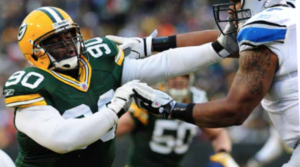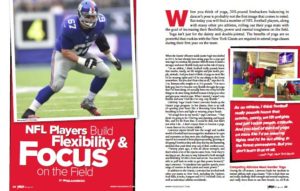 When you think of yoga, 300-pound linebackers balancing in dancer’s pose is probably not the first image that comes to mind. But today you will find a number of NFL football players, along with many other pro athletes, rolling out their yoga mats with the goal of increasing their flexibility, power and mental toughness on the field.
When you think of yoga, 300-pound linebackers balancing in dancer’s pose is probably not the first image that comes to mind. But today you will find a number of NFL football players, along with many other pro athletes, rolling out their yoga mats with the goal of increasing their flexibility, power and mental toughness on the field.
Yoga isn’t just for the dainty and double-jointed. The benefits of yoga are so powerful that rookies with the New York Giants are required to attend yoga classes during their first year on the team.
When the Giants’ offensive tackle Justin Pugh was drafted in 2013, he had already been doing yoga for a year and was eager to continue his practice with the team to build a stronger and more flexible body and cut his risk of injury.
“As an athlete, I think football really pounds home that macho, manly, we lift weights and just tackle people, attitude. And you kind of think of yoga as more like I’d be wearing tights and I’d be out sitting in the forest somewhere. But you don’t learn that at all,” says the 6 ft. 5 in. lineman who weighs in at 310 pounds. “I’m not a little guy, but I’ve become very flexible through the yoga that I’ve been doing. It’s actually been one of my favorite things to do since  being drafted because it helps you relax and gets your mind at ease. When I started, I wasn’t very flexible and now I feel like I’m very, very flexible.”
being drafted because it helps you relax and gets your mind at ease. When I started, I wasn’t very flexible and now I feel like I’m very, very flexible.”
Celebrity Yoga Coach Gwen Lawrence heads up the Giants’ yoga program. In her classes, there is no talk of opening your heart like a blooming lotus flower, breathing in love and light or wearing prayer beads.
“It’s tough love in my world,” says Lawrence. “They think it’s going to be ‘OM’ing and chanting and hippie like, and it’s far from that. It could be that, but that’s not what I do…I don’t expect them to become a yogi. I want them to be a better athlete.”
Lawrence injects herself into the rough and tumble world of football and encourages her students to be open and expressive as they move into challenging poses. She says it’s not unusual to hear players groaning, grunting or dropping f-bombs as they sink deep into hip and hamstring stretches that push them way out of their comfort zone.
“Twenty years ago, it was all about strength, and that’s where a lot of the injuries came from. Now they’re starting to see, the way to stay balanced is both strength and flexibility. It’s like a bow and arrow. You need to be able to pull back in order to get that power forward,” says Lawrence. “It translates into quicker speeds, more range of motion in their joints and more power.”
In addition to the Giants, Lawrence has worked with other pro teams in New York, including the Yankees, Red Bulls, Knicks, Rangers and NYC Football Club, as well as individual athletes worldwide.
Competing Athletes Need Gentler Yoga
During the off-season, Lawrence leads her students in intense athletic-style yoga classes: “I like to kick their ass and really challenge their strength and mental toughness, and really force them to use their breath. So, we’ll do more vinyasa flow.” However, when football season kicks off in the fall, Lawrence changes her focus to yin-style yoga, emphasizing long, deep holds and more restorative poses to help them recover after games.
“The slower deep holds are my favorite ones, where you’re really stretching it out, opening up your hips, groin, back and shoulders,” says Pugh. “When you’re playing football, your body ends up folded in different positions and yoga really helps. When there’s a pileup of five to 10 guys and they’re all 300 pounds, and you’re all squished together in a pile, it will help you to hold that position and know how your body works.”
Although Pugh is no longer required to attend yoga classes with his team, he is committed to continuing his practice: “My biggest thing is injury prevention. And with the position I play, the more flexible you are, the better you can move.” The 25-year-old has also incorporated wrestling and boxing into his training and adopted a gluten-free diet. “Yoga makes me more aware of my body and what I eat.”
Yoga Corrects Sports-Specific Imbalances
Like most sports, football creates imbalances from overtraining because you’re often one side dominant. “You’re either hitting on one side or throwing from one side, and you start to create these strength and flexibility imbalances,” says Lawrence. “And if you don’t address them, you’re going to wear and wear and wear on certain joints and certain muscles until they blow, and I think that’s where a majority of injuries come from.” Yoga helps strengthen weak muscles and open up tight, constricted areas to reduce the risk of injury.
Greenbay Packers defensive tackle B.J. Raji has worked with Lawrence to help him heal from a football injury. He first started doing yoga after a bicep tear in a 2014 pre-season game that sidelined him for the entire season: “After doing yoga, I started to notice a vast improvement in a short amount of time. I was able to actually have more range of motion than I had prior to the injury.”
After a year of practicing yoga regularly, Raji says he has regained the flexibility he had lost since being drafted in 2009. “Playing that many plays for consecutive years tightened up my body and my joints and constricted my muscles. Ironically, when we had flexibility testing at the beginning of this spring, I had the best numbers since I was a rookie, and this will be my seventh year.”
Now that Raji has increased the flexibility in his hips, he’s noticed more lateral quickness and the ability to sink down deeper and faster into a squat: “No matter what sport you’re playing, if you can sink the center of gravity at will, you have a decisive advantage over a lot of people. I’m able to use my power in ways that I wasn’t able to use it before. I feel a huge difference just day to day, as far as my shoulders. And the joints in my hips and ankles are looser.”
Athletes Build Mental Toughness
When training athletes, Lawrence not only works their bodies, but also their minds. Holding a tough hip-opening pose such as pigeon or a deep backbend can challenge even the most seasoned of athletes.
“I sink them into poses where they’re literally holding them for two to five minutes, and they really are forced to use their breath and tune in and see what they feel. They build mental toughness because they have to stay in the pose and find comfort in an uncomfortable situation, and it forces them to focus,” says Lawrence. “Many athletes say it is the hardest thing they have to do.”
Lawrence also integrates meditation, visualization and goal-setting into her yoga teaching. She recently taught a “Mindful Athlete” course to all the Giants’ coaches, trainers and rookies to give them an edge over the competition. An important aspect of this mindfulness training is having the players write down their goals and take steps every day that bring them closer to their goal, such as having an injury-free season.
“People that actually put their goals pen to paper increase the likelihood of achieving their goals to the tenth power – not 10 times, but to the tenth power,” says Lawrence. So, it’s a really, really powerful practice.”
Stretching Reduces Recovery Time
One of the often overlooked benefits of yoga stretching is faster recovery time. Raji says he has noticed less muscle soreness after intense football drills and weightlifting.
“A lot of people can train, but can they show up and train the same way on a consistent basis? That’s what yoga affords me the opportunity to do,” says the 330-pound, 6 ft. 2 in. lineman. “I can work out hard and come back the next day and give off the same effort, if not more, because in the back of my mind I’m not worried about how I’m going to feel after.”
Raji is starting the 2015 football season completely healed from his right bicep tear and feeling more confident than ever. “With the combination of my strength and my flexibility, I think my best years of football are ahead of me. And that’s ironic because they usually say that the older you get in my league, the closer you are to the exit, but with yoga I don’t feel that way,” says the 29-year-old free agent who re-signed a one-year contract with the Packers last spring.
Although the Packers players are not required to do yoga, Raji says he plans to practice yoga throughout his career, so he can maintain his flexibility and reduce his risk of injury.
“Guys that generally do yoga are the guys who are looking for an extra edge, and I think that’s the driving force behind it – just knowing how much it works and how relaxing it is at the same time,” says Raji. “I feel that yoga takes me to the next level.”